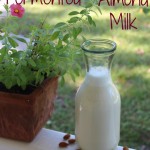
Probiotic Homemade Almond Milk
Recipe for homemade almond milk that is lightly fermented to add probiotics and additional nutrition.
Ingredients
- 2 cups raw almonds preferably organic and unpasteurized
- filtered water
- 1/4 cup liquid whey
- 1/4 cup raw honey
- 1 tsp vanilla extract
- 1 tsp almond extract
- 2 tsp sea salt
Instructions
-
Almond milk is best made from skinless almonds. This way, the smooth almond pulp can be retained in the final beverage for extra nutritional value instead of strained out and discarded. Leaving the skins on also greatly increases the chances for mold during fermentation.
-
If you don't already have skinless (blanched) almonds, you will need to remove the skins yourself. To do this, place almonds in boiling water for one minute (no longer!). Immediately strain in a colander and rinse with cold filtered water. Pat dry with a towel. Pinch off the skins with your fingers.
-
The skins will easily slide off. It takes me about 20 minutes start to finish to blanch and then remove the skins from 2 cups of almonds. This is a wonderful fine motor skills activity for young children, by the way.
-
Soak almonds overnight in filtered water with sea salt. Soaked almonds infinitely more digestible than if the almonds are unsoaked. Drain off soaking water, rinse and process almonds in a food processor until a smooth paste. In a 2 quart glass jug (I like these) mix almond paste with other ingredients and enough filtered water to fill the jug. Take care to leave at least one inch at the top.
-
Cover tightly and leave on the counter for 2 days to ferment. This cultures the almond milk, adding probiotics and beneficial enzymes to the mixture.
-
Refrigerate. Be sure to gently stir homemade almond milk each time before serving.
-
Enjoy. This almond milk recipe is absolutely delicious and can be used as a replacement for dairy milk in all your recipes or just to enjoy on its own, sipped from a glass.
Recipe Notes
Use almond milk starter culture if you wish to avoid using liquid whey.
Use sprouted almonds for an even more digestible and nutritious beverage.